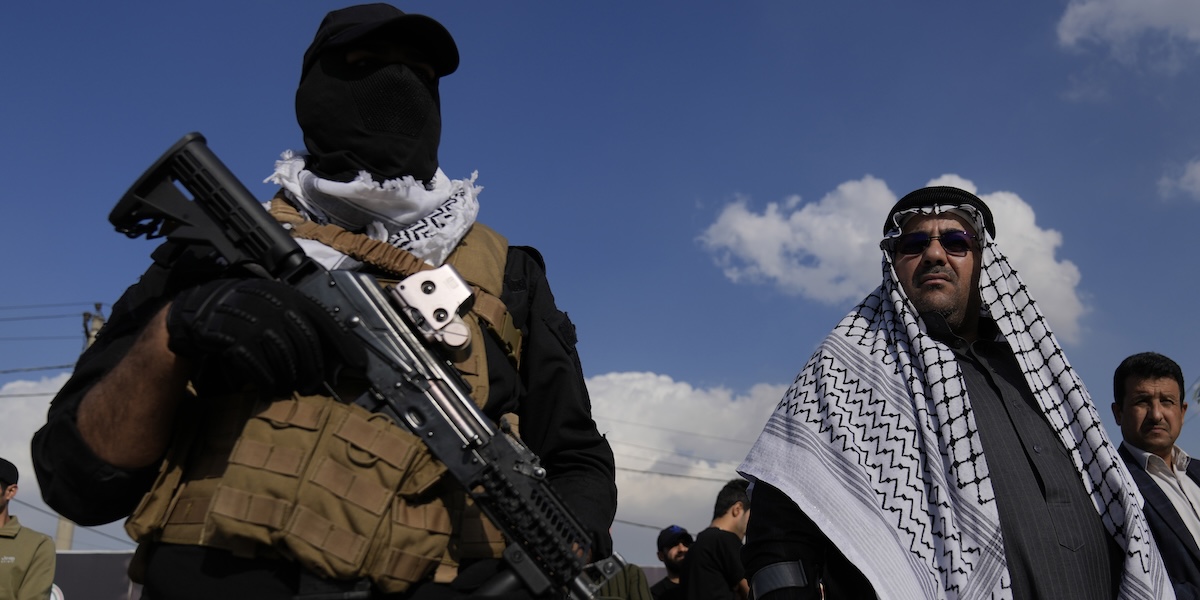Loading player
The United States conducted a drone strike in Baghdad, Iraq, on Wednesday, hitting a car carrying members of Kataib Hezbollah, an Iranian-backed Shiite militia believed to be responsible for the attack on a U.S. military base in Jordan. in which three soldiers died. Kataib Hezbollah is one of the many pro-Iranian militias operating between Iraq and Syria: it is considered one of the most structured and numerous in a context in which many groups are active, sometimes allies, sometimes competing, but financed and led more or less directly by the Revolutionary Guards , Iran’s most powerful military force, which has enormous influence throughout the region.
Various pro-Iranian militia groups have been conducting attacks against US targets for years, but have made them more intense and frequent since the start of the war between Israel and Hamas. There were more than a hundred after October 7, conducted with rockets, drones and short-range ballistic missiles.
Kataib Hezbollah and the other groups operating in Iraq and Syria are Shiite groups, which have the Iranian revolution of 1979 as their reference. In recent years, Iran has extended its influence over the Middle East area, financing and arming political-military groups in various countries with the aim of creating what Iranian generals define as an “axis of resistance”, that is, a complex of alliances in various countries capable of countering the United States and Israel. It includes Hamas in Palestine (which is also a Sunni group), Hezbollah in Lebanon, Houthis in Yemen, as well as the Shiite militias in Iraq and Syria.
Membri at Kataib Hezbollah a dicembre a Baghdad (AP Photo/Hadi Mizban)
In Iraq and Syria, Shiite militias began their activities after the US invasion of 2003, in the Second Gulf War: however, they became much stronger and more organized a decade later, during the war waged against the Islamic State (ISIS). In 2014 the various militias organized themselves into the Popular Mobilization Forces (Al Hashd Al Sha’bi, or PMF), which became the main Shiite opposition force to ISIS: after the substantial defeat of the Islamic State, the PMF began what they define as standoff, “resistance”, towards the United States and their allies (especially Turkey).
The concept Of resistance it is the basis of all Shiite militias, expressed as resistance against the oppressor, the foreign occupying forces, the hegemonic powers: it refers to the martyrdom of Hussein ibn Ali, grandson of Muhammad, in battle of Karbala of the 7th century.
In the area, pro-Iranian militias tend to consider the borders between Iraq, Syria and Lebanon as structures imposed by Westerners and for this reason they often operate transnationally, although maintaining very strong local rivalries and interests.
The Popular Mobilization Forces are now recognized as part of the Iraqi state security forces, and the various militias provide specific battalions to the country’s army, thus maintaining relationships with the central government. Many of their militiamen are paid as army soldiers and their commanders often have leadership positions in the same. At the same time, the militias guarantee themselves a certain freedom of action, as confirmed by the recent attacks on US positions, which the Iraqi government does not officially approve of, at least officially.
The general Qassem Suleimani and Abu Mahdi al-Muhandis in a mural in Baghdad (AP Photo/Hadi Mizban)
Kataib Hezbollah is one of the most numerous of these accredited militias of 20-30 thousand men: was born in 2003, has been defined as a terrorist organization by the United States since 2009, has conducted attacks and attacks with rockets, firearms and car bombs. Currently it can also count on drones and short-range missiles of Iranian origin. It was led by Abu Mahdi al Muhandis, killed in 2020 by the American attack which had as its main objective the Iranian general Qassem Suleimani, considered one of the main architects of the policy of Iranian influence through armed militias.
In Wednesday’s attack, the current commander, Wissam Mohammed “Abu Bakr” al Saadi, was killed. Since 2021, Kataib Hezbollah also has a more purely political wing (albeit with unofficial ties), with some representatives in the Iraqi parliament. It is also common to other Iraqi militias such as Asaib Ahl al Haq and the Badr group, considered rivals for reasons of recruitment, prestige and operational choices, but with which Kataib Hezbollah shares inspiration and Shiite financing.
Nujaba militiamen during a funeral (AP Photo/Anmar Khalil)
The Nujaba militia, on the other hand, is solely military, the most active especially after the first US military response: it is believed to have conducted over 90 of the 130 attacks against American targets in the last period. Its leader, Akram al Kaabi, has constant relations with the Iranian political and military leaders and has also been received by the Russian government on an “official” visit. Nujaba has repeatedly accused other militias in Iraq of not “doing enough” against the United States to defend the Palestinian people. She was objectified of a specific attack by US drones on January 5, which had as its main target Mushtaq Jawad Kazim al Jawari, one of the highest-ranking members of the organization, who was killed in the attack.
Many of these militias also operate in Syrian territory, where the situation is further complicated by the civil war that has been ongoing for over a decade. Pro-Iranian militias have often been a decisive support for the authoritarian regime of President Bashar al Assad. Many of the military forces operating came from the countries of the area: not only the Iraqi militias, but since 2013 the Lebanese Hezbollah and then the Afghan and Pakistani Shiite guerrillas, organized by the Iranian Revolutionary Guards in the Fatemiyoun brigades (they have around 15 thousand men at their disposal) .
